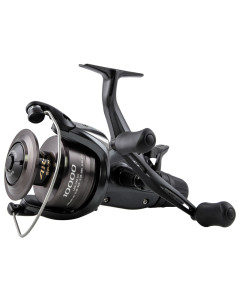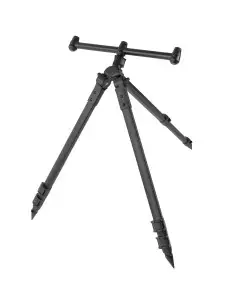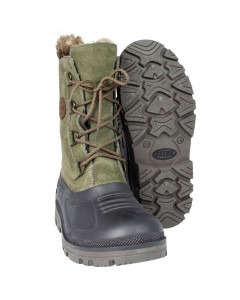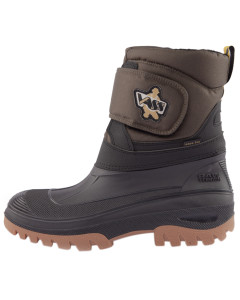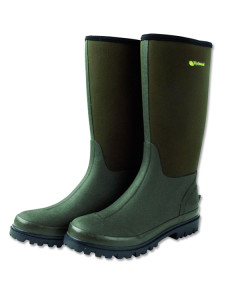This is a demo store. No orders will be fulfilled.
Barbel Fishing in Autumn: Tips for September Sessions

The trees are showing their golden finery and the evenings are becoming crisper. It is prime time for many specimen barbel anglers to get the trusted barbel fishing rods out.
There’s nothing quite like the thrill of battling a big fish as the first whispers of autumn touch the riverbanks. To ensure your autumn sessions are memorable for all the right reasons, there are some tips to consider.
Barbels are a hard-fighting fish. This makes barbel fishing an exciting experience. If you're new to the barbel fishing world, this article will cover some essential tips. From tackle selection, and best barbel baits to expert tips to give you an edge at the river bank.
Barbel, what time of year?
You can fish for barbel for most of the year. Below are some seasonal insights that may assist with barbel angling in the UK.
Spring: Spring is largely a no-go for barbel fishing because of the closed river season (March- June). This is to allow fish like barbel to spawn without additional pressures.
Early Summer: This is a viable time to fish for barbel. It can be challenging because of their decreased exposure to anglers' baits, during the non-fishing period. Try night fishing for barbel during this time.
Late Summer: With summer comes the heat. Be sure to check for water levels, ideals a little rainfall before setting off for your river barbel session. During this time of year, you can fish into the evening with longer daylight.
Autumn: This period stands out as the peak of the barbel fishing season. If the temperature is climbing and there's high water or flooding, you will find great success.
Winter: Even in the colder months, barbel can still be a tempting catch, provided the water temperature remains favourable. The consensus is that barbel activity drops around 5 degrees Celsius. The barbel are at their heaviest, making it a rewarding time to fish.
Why Should I Go Barbel Fishing in Autumn?
As temperatures drop, barrels (Barbus barbus) enter a sort of "feed frenzy". They need to stack up on reserves for the cold months ahead. As a result, they become more aggressive and feed more frequently. They're no longer in the shadowy depths but roam more freely, offering anglers a great shot at a successful catch.
September, being the bridge between the warmer summer and chilly winter, is just the right time for this. Plus, the rivers are often clearer, giving barbel fewer places to hide.
How do you start barbel fishing?
Starting with barbel fishing requires a combination of the right equipment, techniques, location, and understanding of the fish's behaviour.
Where is the best place to fish for barbel?
By researching rivers and stretches you can fish places with barbel presence. Some well-known spots include barbel fishing on River Wye, Severn, and Trent. However, local fishing forums and tackle shops can offer valuable insights.
Barbel Fishing Near Me
Barbel Fishing on the River Trent
Barbel Fishing on the River Severn
Best Barbel Fishing Setup
- Rods: A specialist barbel rod with a test curve of around 1.5 to 2.5 lbs is ideal. Barbel can give a substantial fight, especially the larger specimens, so you’ll want something that offers both power and flexibility.
- Reels: A decent fixed-spool reel with a smooth drag system.
- Line: Mainline of about 10-15lbs breaking strain is ideal. Ensure your line is abrasion-resistant.
- Leads/Feeders: Use feeders or ledger weights to help present your bait properly in the river's flow. Use a heavy lead (3oz or more) to hold the bottom of the riverbed in strong flows.
- River Rod Pods: Utilising rod pods and fishing tripods can be essential when positioning your rods by the water. Especially when dealing with rivers with shallow margins.
- Barbel Fishing Rigs: The hair rig, ideally with a bolt rig system, is a great rig for barbel fishing. This setup allows the barbel to hook themselves immediately after picking up your bait.
Can you use carp rods for barbel fishing?
You can use carp rods for barbel fishing occasionally. Anglers use carp rods to cast smaller weights over long distances, with accuracy. They might not offer the same feel as dedicated barbel rods.
Barbel rods usually have a through-action, allowing them to cast heavier weights effectively. However, carp rods with a through-action and barbel rods with a stiffer build are also available.
If you're considering an impromptu barbel trip and only have carp rods, it's better to bring them. Especially if you spot an ideal distant location to cast your bait. Always check the rod's casting weight and flexibility before using it.
What size hooks for barbel fishing?
Sizes 10-14 barbel hooks are generally suitable, but this might vary depending on the bait.
Best Barbel Fishing Technique for Beginners
Ledgering is one of the most common techniques. This is where you cast your baited rig into the river and let it settle on the bottom.
Be patient. Barbel bites can sometimes be subtle with just a few knocks, or they can be ferocious, pulling your rod tip down.
Can you float fish for barbel?
You can float fish for barbel. Ideally, choose a spot that's shallow, which then deepens. Use a large stick or Avon float, weighted between 3g to 8g, based on the water's conditions.


Top Tips for Barbel Fishing
Where do barbel sit in the river?
Barbel love river features. Look for deeper holes, undercut banks, gravel runs, and areas behind obstructions. Obstacles like rocks or overhanging trees tend to have barbel hiding there.
Barbel will often sit there for shelter from the main current. However, they still have access to passing food. Often, barbel are in faster-flowing, oxygen-rich waters.
Every river has its character. Observe and learn from every trip. Sometimes, the smallest observation can lead to the biggest catch!
What is the best bait for barbel fishing?
Catching barbel hinges significantly on bait choice. Here are the top baits that have proven effective for many anglers:
- Luncheon Meat: A tried-and-true favourite that consistently attracts barbel.
- Maggots: Their lively movement is tempting to barbel.
- Sausage: Though uncommon, it can be an effective hook bait in some waters.
- Barbel Pellets: These fish pellets offer great appeal to barbel. Halibut pellets tend to do well with attracting big barbel in solid PVA bags.
- Boilies: Crushing them helps disperse flavour, drawing barbel in. Opt for high-protein boilies in meaty or spicy flavours. Garlic, cheese, and shrimp are particularly effective.
- Pastes: Using pastes made from crushed pellets or boilies can be particularly productive. The slow breakdown of the paste releases attractants over an extended period, luring Barbel to your hook.
- Particles: Hemp, maize, and tigers can be potent if pre-soaked and boiled properly. Introducing them via PVA bag fishing or loose feeding can get the fish feeding confidently.
- Groundbait: A mix of particle baits and groundbait can attract barbel into your swim and keep them there, searching for food. Again, fishing with PVA bags can be devastating.
It's important to remember that effectiveness can vary depending on the water and conditions. Experimenting with different baits will help you discover the best option for your specific location.
Pre-baiting can be effective. Plan on a certain fishing spot, baiting it a day or a few hours before can draw barbel into the area.
Do Barbel Like Robin Red?
Designed by Haith’s, Robin Red is a rich, deep red blend. Robin Red, made of spices, sugars, oil, and crushed seeds, portrays its sweet and peppery flavour. Renowned for its vibrant natural red hue, it stands as one of the most favoured ingredients in boilie mixes.
This additive has elevated many of Europe's top boilies, groundbaits, and pellets. It has also effortlessly enhanced everyday baits like sweetcorn and chickpeas right out of the tin.
While popular among carp, baits infused with Robin Red powder are equally effective for attracting barbel and tench. In essence, barbel, along with other fish, indeed has a fondness for the flavours introduced by Robin Red.
How long should your hair be for barbel?
Barbels have powerful fights in them. A hair rig for your bait can work wonders. To prepare a hair rig for boilies and pellets, make sure to leave a 1cm gap. This gap should be between the bend of the hook and the start of the bait.
However, when hair rigging meat, adjust so the bait is in direct contact with the hook's bend. This ensures optimal presentation for each bait type.
How Do You Fish for Barbel on a River?
- Locate the current in the river
- Cast your bait upstream, allowing it to naturally drift downstream with the flow.
- Use baits like boilies, pellets, or meat that barbel favour
- Barbel tend to bite on bait that appears as naturally drifting food in the water
- Correctly set your tackle so you can detect subtle bites and handle the strong fight of a hooked barbel.
Best Weather for Barbel Fishing
Barbel, although relatively resilient to weather changes can certainly show distinct behavior during extended periods of specific weather conditions. Lots of rain can raise the river levels and increase the water flow. This often stimulates barbel to feed more actively.
Conversely, prolonged cold spells can slow down their metabolism, making them less responsive. It's crucial to monitor weather patterns and river conditions for several days leading up to your fishing trip.
What time is best for barbel?
September mornings can be magical. Barbel fish love to feed during dawn and dusk. While many have success during the day, consider setting out early or staying a bit later to increase your chances.
As mists rise from the river's surface, the early hours often present the best chances. Barbel feed actively during dawn and late afternoon. Align your sessions with these times to maximize your chances.


Safety when River Fishing
Consider the safety needs for yourself and for the fish. Barbel, with their long, slender bodies, can be more fragile than they appear.
Wet your hands before handling them, support their weight evenly, and avoid touching their gills. Once you've taken your photo or admired your catch, release the fish when they are ready. Ensure barbel are swimming confidently before freeing in the stream.
Fish Care: Use a padded unhooking mat to protect the fish when you catch them. Consider using barbless hooks or hooks with micro-barbs for easier unhooking and less damage to the fish.


River Safety: River banks can be slippery, especially after some downpours. If you are fishing alone, do not attempt to walk down or climb steep river banks. Be sure to always let others know where and how long you are barbel fishing for.
Learning and Adapting
Consider joining local fishing groups or online forums. Sharing experiences helps you to learn from others. It can provide insights that refine your autumn barbel techniques.
Fishing is as much about community as it is about the catch. You could also read barbel fishing books, watch videos, and continue to educate yourself on the behaviours and preferences of barbel.


Respect the Environment when River Fishing
River fishing provides a serene connection to nature. With this honour comes the responsibility of looking after the environment.
Catch and Release: Practice the catch-and-release method diligently. This helps fish populations to stay healthy.
Leave No Trace: Cleaning up after yourself isn't just about aesthetics; it's vital for the health of the river ecosystem. Discarded lines, hooks, and other trash can be harmful or even fatal to wildlife. Always pack up the tacke you pack into your luggage.
Fishing Licence: Ensure you possess the appropriate licenses or permissions for the waters you're fishing. These rules help fish stocks and balance the aquatic ecosystems.
Mindful Bait Choices: Use baits that are non-toxic and environmentally friendly. Avoid introducing non-native species into the water.
Tread Lightly: Be cautious of where you walk or set up. Riverbanks can be fragile. Lots of stomping can cause damage to vital habitats.
Educate and Advocate: Share the principles of environmental respect with fellow anglers, especially newcomers. Collective mindfulness ensures the longevity and health of our rivers.
Remember, every angler plays a part in conserving the pristine beauty and health of our rivers. Ensure they continue to thrive for generations to come.
Barbel fishing in the autumn is more than just a hobby. It's a communion with nature, a lesson in patience, and an exercise in strategy. With the right tips, and techniques your autumn river sessions can yield memorable catches.
So, next time you're out by the riverside, think of these tips. Embrace the wisdom, enjoy the serenity of autumn, and relish the thrill that barbel fishing brings.


FAQs on Barbel Fishing
Why am I not catching barbel?
Not catching barbel can result from various factors. Using the incorrect bait or fishing in unsuitable weather conditions can be the issue. Alternatively, the presence barbel may be lacking in the chosen location.
Ensure you're using appropriate bait, fishing during optimal times, and researching your chosen spot for barbel activity.
How much bait do you need for barbel?
For barbel fishing, it's a good idea to pack extra and adjust based on the fish's activity. Overfeeding can deter barbel, while underfeeding might not attract them sufficiently. Observe and adapt to the barbel's feeding patterns during your session.
Do barbel like deep or shallow water?
Barbel often prefer deeper waters during the daytime for protection and move to shallower areas during dawn and dusk to feed. However, their exact preference can vary based on the water temperature, flow, and season.
Do barbel eat cheese?
Cheese can attract barbel, especially strong-smelling ones. Cheese can be an effective bait alternative when traditional baits aren't working.
Can you catch barbel during the day?
Barbel are often most active during dawn and dusk. However, they anglers can still catch them during the day. Fish for barbel in overcast conditions or in deeper, shaded waters.





